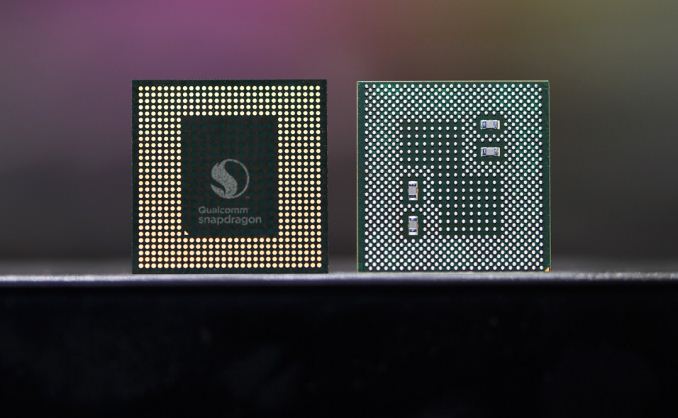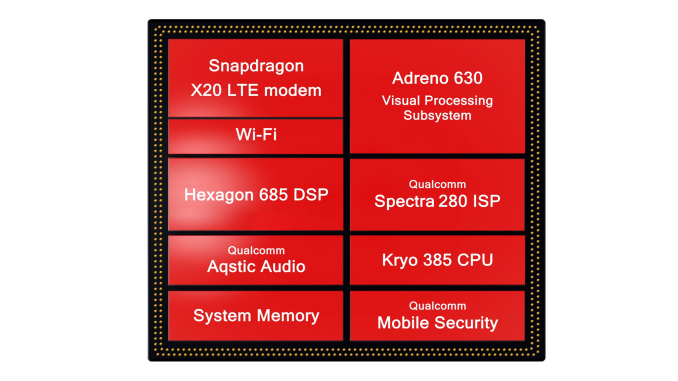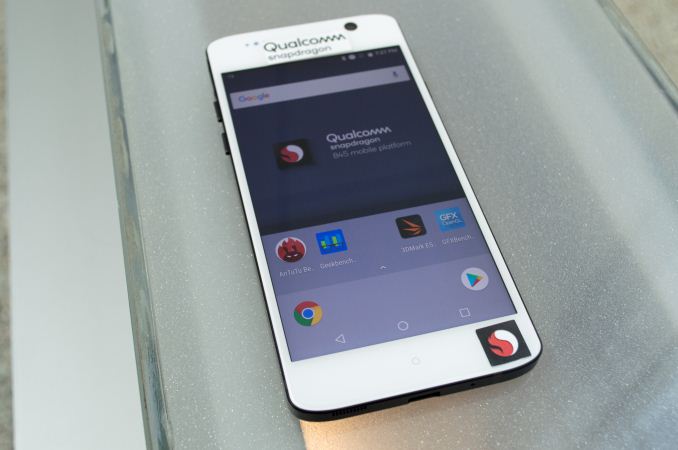The Snapdragon 845 Performance Preview: Setting the Stage for Flagship Android 2018
by Ryan Smith & Andrei Frumusanu on February 12, 2018 12:30 AM EST- Posted in
- Mobile
- Snapdragon
- Qualcomm
- Smartphones
- SoCs
- Snapdragon 845

In what has become an annual tradition for Qualcomm, the company has once again opened the doors of their San Diego headquarters to the press to take a preview look at the next generation of their flagship mobile platform. These events have been going on for several years now, and have become an integral part of how Qualcomm approaches the public with their wares; preview events not only let them set expectations, but to get the word out to technically-minded audiences in a vendor-neutral manner. Rather than being one part in the next flagship smartphone, preview day means that everything can be about Qualcomm and the platforms that they have created.
Late last year Qualcomm announced the Snapdragon 845 platform, the successor to 2017’s Snapdragon 835. Implementing a number of important architectural improvements over its predecessor, the Snapdragon 845 gets to follow-up on what ended up being a rather well-received platform in the Snapdragon 835, and to see if Qualcomm can maintain their momentum. Qualcomm used their December event to release a good bit of info on the 845 in advance, so we’ve already had a chance to see what Qualcomm is planning architecturally. And now with the preview event we finally get to see how all of this comes together with a look at the platform as a whole.
Whenever discussing the state of affairs of Qualcomm’s flagship SoCs, I always struggle not to tie it to the Snapdragon 810 in some fashion. Which not to beat Qualcomm over the head for past mistakes – in that case a poorly thought out response to Apple – but rather because it serves as a such a great point of reference for discussing the company’s SoC development as a whole. 810 was arguably the company’s low point, so everything since then has been part of a rather remarkable upward trajectory for the flagship Snapdragon. Even though Qualcomm has been leading the pack in high performance SoCs for several years now, last year’s Snapdragon 835 in particular really felt like Qualcomm was in that position for all-around technical capabilities and not merely because of size, momentum, and the realities of LTE licensing.
All of this means that there’s a lot riding on the Snapdragon 845, just in a different and less obvious way than before. Qualcomm has redeemed themselves from the 810 and it’s not a question of whether they can put together a great SoC, but instead it’s a question of how they will follow up upon a great SoC like the 835.
| Qualcomm Snapdragon 845 vs 835 | |||
| SoC | Snapdragon 845 | Snapdragon 835 | |
| CPU | 4x Kryo 385 Gold (A75 derivative) @ 2.8GHz 4x256KB L2 4x Kryo 385 Silver (A55 derivative) @ 1.77GHz 4x128KB L2 2MB L3 in DSU |
4x Kryo 280 Gold (A73 derivative) @ 2.45GHz 2MB L2 4x Kryo 280 Silver (A53 derivative) @ 1.90GHz 1MB L2 |
|
| GPU | Adreno 630 | Adreno 540 @ 670/710MHz | |
| Memory | 4x 16-bit CH @ 1866MHz LPDDR4x 29.9GB/s 3MB system cache |
4x 16-bit CH @ 1866MHz LPDDR4x 29.9GB/s |
|
| ISP/Camera | Dual 14-bit Spectra 280 ISP 1x 32MP or 2x 16MP |
Dual 14-bit Spectra 180 ISP 1x 32MP or 2x 16MP |
|
| Encode/ Decode |
2160p60 10-bit H.265 720p480 |
2160p30 (2160p60 decode), 1080p120 H.264 & H.265 |
|
| Integrated Modem | Snapdragon X20 LTE (Category 18/13) DL = 1200Mbps 5x20MHz CA, 256-QAM UL = 150Mbps 2x20MHz CA, 64-QAM |
Snapdragon X16 LTE (Category 16/13) DL = 1000Mbps 3x20MHz CA, 256-QAM UL = 150Mbps 2x20MHz CA, 64-QAM |
|
| Mfc. Process | 10nm LPP | 10nm LPE | |
The answer to that comes in the form of the Snapdragon 845, an interesting SoC that is a “tock” design if there ever was one. Qualcomm doesn’t get the advantage of an entirely new manufacturing node – the 845 is being made on Samsung’s second-generation 10LPP process, a refined version of 10LPE used for the 835 – so Qualcomm’s improvements are rooted almost entirely in architecture rather than a mix of architecture and manufacturing. Which is to say that it’s a bit of an uphill challenge for the company, but the flip side of that argument is that it’s going to be a chance for Qualcomm’s architectural engineers to take attention front and center.
What the Snapdragon 845 entails then, as we originally learned late last year, is a series of upgrades and overhauls across all the various subsystems of the SoC. Arguably the biggest news here is that Qualcomm’s latest-generation Kyro 385-series CPU cores are derived from ARM’s Cortex-A75 and A55 designs, and that the resulting SoC is the first to employ ARM's DynamiQ CPU cluster organization. DynamIQ enables the various different CPU cores within an SoC to be hosted within the same cluster and cache hierarchy, as opposed to having separate discrete clusters with no shared cache between them, allowing for finer-grained and more efficient approaches to when and how various clusters are powered up. Meanwhile on the GPU side, the notoriously tight-lipped GPU group over at Qualcomm has confirmed that the Snapdragon 845 implements the first Adreno 600 series GPU, which in turn is the first new GPU architecture from Qualcomm in a couple of years and promises some significant performance improvements.
Outside of the core processor architecture, the changes in the rest of the SoC are perhaps not quite as dramatic, but still important to the platform as a whole. This includes, of course, Qualcomm’s latest and greatest LTE modem, the Snapdragon X20, upgrading Qualcomm’s LTE capabilities category 18. Both the camera ISP and Hexagon DSP have also been upgraded as well with the introduction of the Spectra 280 and Hexagon 685, which Qualcomm will be leveraging for camera image quality improvements and their stake in the modern mobile AI race respectively. Finally, the SoC also includes the latest version of the company’s Aqstic audio codec, which although audio has not traditionally been heavily promoted by the company, will be an increasingly important part of differentiating itself from other high-performance mobile SoCs.
Getting down to the heart of matters then, this year’s flagship Snapdragon platform preview is a lot like last year’s. We’re once again taking a look at a Qualcomm Reference Design (QRD), which is a fully functional smartphones in a slightly oversized, utilitarian chassis used for hardware testing and software development. The Snapdragon 835 QRD was a 5.5-inch equivalent phone, and for the 845 QRD Qualcomm has stuck with much the same. The device itself is unremarkable, featuring a 1440p LCD and 6GB of LPDDR4X memory, but it’s otherwise typical of the class of Snapdragon 845 devices we expect to see starting a bit later this year.
Similarly, while this is still a preview, final device performance shouldn’t be too much different from what we see with Qualcomm’s QRD. Vendors do make customizations to both hardware and software, so how a device’s cooling system is built or how aggressive the power management is configured will have an impact on final performance. But as far as stock performance goes, the QRD is about as neural as it gets, if not a slightly idealized case for the platform as it allows Qualcomm to optimally configure the phone themselves.












140 Comments
View All Comments
Lodix - Monday, February 12, 2018 - link
That they make their own chip.ZolaIII - Monday, February 12, 2018 - link
Actually A75 is a bit of a let down. As it's actually refined A73 with tree instructions per clock vs two. I assume that with larger cache, bigger predictor & everything else it's also close of being 50% larger while it's able to achieve only 20~25% performance advantage. Nevertheless if compared to A71 which is similar 3 instructions per clock design advantage is nice 30~35%. Neither is really a server material & you know that pretty good (of all people around hire). We will have to wait & see what Austin will cook up next.ZolaIII - Monday, February 12, 2018 - link
One more thing FP VFP & especially NEON got a most significant boost with A75 - A73, that's actually only really architectural improvement on this generation. FP performance is very important as it scales rather good on the SMP while integer doesn't. Still giving MP scaling factor & relative power efficiency/performance the A55's are still much better target for such workloads using 25% power & achieving 85% performance per MHz. Arm's NEON SIMD whose marginally unusable before this gen. as on the previous VFP had 98% of NEON performance while (VFP) being much faster to access so in many real workloads actually faster. ARM boosted NEON performance but in my opinion not even close enough to go in a higher tear. I do agree with you that Integer performance is actually rather very good for small, efficient little OoO core but ARM must do much more on the FP - NEON SIMD if it wants that their cores become more competitive in HPC segment. Actually I see this as a key (FP performance). Hopefully they will produce a next key architectural element of unified SIMD with added multiply, divide subs on it as I see that as the best possible scaling/performance improvement & also as future avoiding of black silicone. Actually regarding large NEON SIMD blocks usage & in the purpose of server scientific HPC workloads the Fujitsu started working on it long time ago (two + years ago). I just wonder what happened with that.iter - Monday, February 12, 2018 - link
You are confusing integer and floating point with scalar and vector. SIMD units do vector processing, the vector components can be either integer or floating point. Both are equally useful in HPC, and both get a massive boost from SIMD processing. It is the ALU and the FPU units that do scalar processing, that is one number at a time, of integers and floating point numbers respectively. Those are not used for data crunching, but for managing the program flow, which is beneficial since the lower throughput also means lower latency.There is no such thing as a free lunch here. If you want to stay at a lower power target, you have to compromise on the SIMD throughput. There is no way to cheat around that. If ARM chips get SIMD units to match x86 counterparts they will also match their higher power usage.
ZolaIII - Monday, February 12, 2018 - link
Lol both scalar and vector are FP. I ain't confusing anything, you are... SIMD's are rather efficient, more efficient for an order of magnitude compared to the VFP, that's why SIMD arias find their way to pretty much any special purpose or general purpose computing unit's. What I told is a massive united heterogeneous SIMD aria... Now think about it.iter - Tuesday, February 13, 2018 - link
You are such a dummy. Scalar means "one number", vector means "two or more numbers". The number can be an integer or a floating point number. SIMD instruction sets feature dozens of instructions for processing integer numbers, which are essential to image, video and audio processing, which is all stored using integers.In fact, the first SIMD implementation to hit consumer products was intel's MMX, which provided ONLY INTEGER operations.
As I said - scalar operations involve processing one number of a time, and are executed by the ALU or FP unit for integers and real numbers respectively, vector operations involve processing multiple numbers at once, and is handled by the SIMD units, regardless of whether its integers or reals.
lmcd - Monday, February 12, 2018 - link
Wouldn't get too excited, as A75 was reported to feature a variant of the "Meltdown" bug also affecting Intel CPUs. Performance hit for a patch could be damaging.SirPerro - Monday, February 12, 2018 - link
I'm more interested in the mid-range processors to drive devices like the Moto G Plus seriesRight now, an SD845 is extraordinarily excessive for like... 95% of the Android use cases.
It's like... "OK, that 1080 Ti GPU is really nice, but how good is the 1060 I will actually pay for?"
imaheadcase - Monday, February 12, 2018 - link
The irony of all this is that software is going to make the difference more than this SoC. You can have the best SoC and put in a shit phone.yeeeeman - Monday, February 12, 2018 - link
First of all nice review Andrei, coming from a romanian guy like you.Related to SD845, this chip is a nice bump over 835, but I cannot help but wonder if this yearly cadence is really a necessity or just a money grabbing, each year, thing.
I want to change my Z3 compact, SD801 phone with something new, but I feel like what is best, has yet to come. In 2019 we will have 5G modems, 11ax wifi chips, new uArch from ARM aaand 7nm. This chip is just a intermediate step to have something to sell this year, but in any case, nice work as usual from Qualcomm.